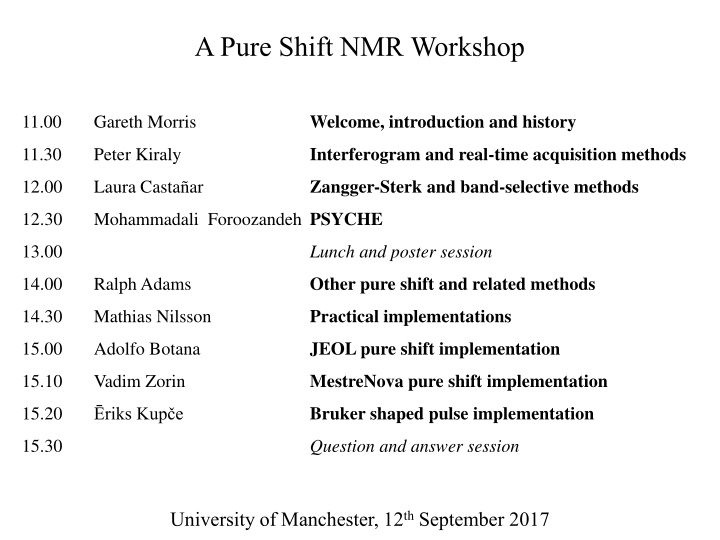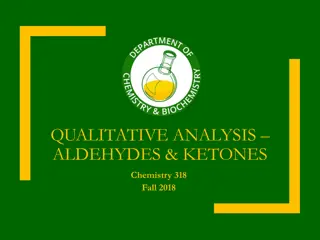Pure Shift NMR Workshop: Advancements and Insights
Explore the latest developments and insights in Pure Shift NMR spectroscopy through presentations on acquisition methods, implementations, and the quest for spectral purity. Discover the evolution of magnet development and the potential of high-temperature superconductivity in NMR technology. Delve into the history of Pure Shift NMR and its theoretical foundations, shedding light on the pursuit of high sensitivity and spectral simplification.
Download Presentation

Please find below an Image/Link to download the presentation.
The content on the website is provided AS IS for your information and personal use only. It may not be sold, licensed, or shared on other websites without obtaining consent from the author.If you encounter any issues during the download, it is possible that the publisher has removed the file from their server.
You are allowed to download the files provided on this website for personal or commercial use, subject to the condition that they are used lawfully. All files are the property of their respective owners.
The content on the website is provided AS IS for your information and personal use only. It may not be sold, licensed, or shared on other websites without obtaining consent from the author.
E N D
Presentation Transcript
A Pure Shift NMR Workshop Welcome, introduction and history 11.00 Gareth Morris Interferogram and real-time acquisition methods 11.30 Peter Kiraly Zangger-Sterk and band-selective methods 12.00 Laura Casta ar Mohammadali Foroozandeh PSYCHE 12.30 13.00 Lunch and poster session Ralph Adams Other pure shift and related methods 14.00 Mathias Nilsson Practical implementations 14.30 Adolfo Botana JEOL pure shift implementation 15.00 Vadim Zorin MestreNova pure shift implementation 15.10 Bruker shaped pulse implementation 15.20 riksKup e 15.30 Question and answer session University of Manchester, 12th September 2017
A Pure Shift NMR Workshop Welcome, introduction and history 11.00 Gareth Morris What ? Why ? Who ? When ? How ?
What Is Pure Shift NMR? A pure shift spectrum is one in which peak positions are , but determined solely by chemical shifts in spectra of systems with homonuclear couplings, a perfect pure shift spectrum is an unattainable ideal: all we can do is to approximate it as closely as possible. Strong coupling sets fundamental limits on our ability to distinguish between coupled spins; and practicalities usually force us to compromise between sensitivity and spectral purity.
A Pure Shift NMR Workshop What ? Why ? Who ? When ? How ?
Magnet Development: Proton Resonance Frequency by Year Maximum commercially available spectrometer field as a function of year, on linear (left) and log (right) scale ? ? MHz MHz 1000 1000 800 600 100 400 200 0 10 1940 1960 1980 2000 2020 1940 1960 1980 2000 2020 Introduction of superconducting magnets
A Pure Shift NMR Workshop What ? Why ? Who? When ? How?
1962 My own work dealt with the construction of high sensitivity radio frequency preamplifiers on the theoretical side, I was concerned with stochastic resonance I tried in particular to design a scheme of homonuclear broadband decoupling to simplify proton resonance spectra. By applying a stochastic sequence with a shaped power spectral density that has a hole at the observation frequency, all extraneous protons should be decoupled without perturbing the observed proton spin. The theoretical difficulties were mainly concerned with the computation of the response to nonwhite noise. Experiments were not attempted at that time, we did not believe in the usefulness of the concept anyway, and I finished my thesis in 1962 with a feeling like an artist balancing on a high rope without any interested spectators. Richard Ernst, Nobel autobiography (1991)
1976 : 45 Projection of a 2D J Spectrum J Chem Phys64, 4229 (1976)
1978 : the Cross-Section Projection Theorem in NMR ... ... ... J Magn Reson31, 133 (1978)
1979 : Constant-Time Evolution J Magn Reson35, 167 (1979)
1982 : BIRD Chem Phys Lett93, 504 (1982)
1997 : Pattern Recognition in 2D J Spectra J Magn Reson124, 104 (1997)
1997 : the Zangger-Sterk Method J Magn Reson124, 486 (1997)
2007 : Anti-z-COSY Magn Reson Chem45, 296 (2007)
2007 : Zangger-Sterk Revisited / Pure Shift DOSY 1/sw1 PFGSTE ZS sequence for DOSY Chem. Commun.2007, 933
A Pure Shift NMR Workshop What ? Why ? Who ? When ? How ?
Pure Shift NMR: Broadband Homonuclear Decoupling Need a general method for separating the effects of shifts ( ) and couplings (J), e.g. Shifts hard 180 pulse - reverses effects of but not of J Couplings active spin refocusing - reverses both and J, but for active spin only, leaving passive spins unperturbed
Pure Shift NMR: Acquisition Methods T t1 t1 Excite Mix Acq Constant-time 2D t1 t1 Excite Acq 2DJ t1 t1 Interferogram Excite Acq ASR (2D style J-refocus 1/sw1 acquisition to build up an interferogram) [ ] Real-time an FID in real time) ASR Excite Acq Acq (acquire n J-refocus
Active Spin Refocusing Methods Divide the available spins into active spins that we observe, and passive spins that we manipulate to suppress the effects of couplings BIRD ZS BS double (PSYCHE) BIlinear Rotation Decoupling: rotation of protons coupled to 13C Zangger-Sterk: slice- / shift- selective rotation Band-Selective homonuclear decoupling: shift-selective rotation PSYCHE / anti-z-COSY: rotation of a fraction sin2 of spins
Classifying Pure Shift Methods: Acquisition Modes 2D 2D J spectroscopy (with 45 projection; absolute value) Filtered 2D J spectroscopy (with post-processing) Pell-Keeler 2D J spectroscopy (with 45 projection) Constant-time (CT) evolution Interferogram Zangger-Sterk BS BIRD PSYCHE R-type Pell-Keeler 2D J spectroscopy Real-time BIRD BASHD Zangger-Sterk
Classifying Pure Shift Methods: Pulse Sequence Types Hard 180 2D J spectroscopy with 45 projection (absolute value) Filtered 2D J spectroscopy (with post-processing) Constant-time (CT) evolution in nD NMR Active Spin Refocusing Band-selective homodecoupling (BS) (shift selection) Zangger-Sterk method (spatial and shift selection) Bilinear Rotation Decoupling (BIRD, isotopic selection) PSYCHE (statistical selection) Hybrid Pell-Keeler 2D J spectroscopy (using ZS, BIRD, BS or PSYCHE) with 45 projection (phase sensitive) Anti-z-COSY (statistical selection)
Zangger-Sterk Pure Shift NMR + + + + + J The combination of a hard 180 pulse and a slice- and shift-selective 180 pulse leaves the active spins (within the slice) unperturbed and the passive (outside the slice or at a different shift) inverted, refocusing the J modulation of the active spins. J. Magn. Reson.124, 486 (1997) Chem. Commun.2007, 933
Mechanics of the Zangger-Sterk Experiment 1/sw1 t1 t2 Soft and hard 180 pulses invert passive spins, refocusing J modulation but leaving shift evolution intact J modulation is slow, so a block of data points lasting 1/sw1 << 1/J can be measured for each value of t1. The residual effect of J is to cause weak sidebands at multiples of sw1.
400 MHz ZS Pure Shift 1H Spectrum of Clarithromycin O HO OMe OH NMe2 O O HO O O O OMe OH O Pure shift spectrum Conventional spectrum J. Am. Chem. Soc.132, 12770 (2010)
Acknowledgments - Manchester Ralph Adams, Juan Aguilar, Adolfo Botana, Liam Byrne, Laura Casta ar, Yingxian Chen, Matt Cliff, Adam Colbourne, Guilherme Dal Poggetto, Rob Evans, Steve Faulkner, Mohammadali Foroozandeh, Saidul Islam, Peter Kiraly, Andy McLachlan, Nicola Meharry, Pinelopi Moutzouri, Mathias Nilsson, Liladhar Paudel, Matthew Powner, John Sutherland, Iain Swan, Jon Waltho Acknowledgments - Funding
A Pure Shift NMR Workshop Welcome, introduction and history 11.00 Gareth Morris Interferogram and real-time acquisition methods 11.30 Peter Kiraly Zangger-Sterk and band-selective methods 12.00 Laura Casta ar Mohammadali Foroozandeh PSYCHE 12.30 13.00 Lunch and poster session Ralph Adams Other pure shift and related methods 14.00 Mathias Nilsson Practical implementations 14.30 Adolfo Botana JEOL pure shift implementation 15.00 Vadim Zorin MestreNova pure shift implementation 15.10 Bruker shaped pulse implementation 15.20 riksKup e 15.30 Question and answer session University of Manchester, 12th September 2017























